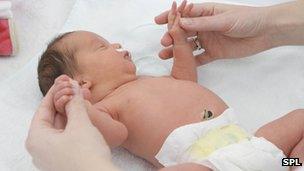Babies boom by a fifth in a decade - ONS
- Published

More babies are being born
The number of babies born in England and Wales has increased by more than a fifth in the past decade, figures show.
Data from the Office for National Statistics (ONS), external showed there were 723,913 live births in 2011, up from 594,634 in 2001 - a 22% increase.
Twins, triplets and other multiple births also increased over the decade, partly due to fertility treatments.
The figures also showed a drop in the number of babies born at home in recent years.
There were 352,939 girls and 370,974 boys born in England and Wales in 2011.
There have been year on year increases in births since 2001 except for a small dip in 2009.
The sheer number of births has raised concerns from midwives about the health service's ability to cope.
The Royal College of Midwives warned last month that maternity units were "under intense strain" and were at a "crucial tipping point".
However, the government says the number of midwives is now increasing faster than the birth rate.
The boom is also putting pressure on school places with some projections estimating that 450,000 new primary places would be needed in England alone by 2015.
One factor behind the rise is thought to be immigration. Figures show 24% of births, external in 2011 were to foreign-born women.
Belinda Phipps, chief executive of parent charity NCT, said: "Whilst these rates continue to rise, it's more important than ever that there is an adequate number of midwifes and they are organised to be there when women need them.
"The most recent data from a Care Quality Commission survey suggests that 22% of women were left alone and worried at some time during labour."
Twins
In 2011, 11,330 women gave birth to twins, 172 to triplets and 3 had quads or more.
This has become more common since 2001 with more than 16 in every 1,000 deliveries now involving multiple births.
Fertility treatment is far more likely to result in multiple births than natural conception.
The ONS report said: "With approximately 11,000 IVF babies being born each year this contributes significantly to the multiple birth rate."
The fertility regulator, the Human Fertilisation and Embryology Authority, aims to reduce the multiple birth rate.
Its latest figures, external showed 35% of IVF cycles now involved the transfer of just one embryo.
- Published21 January 2013
- Published26 July 2012